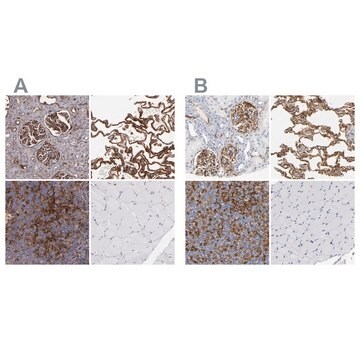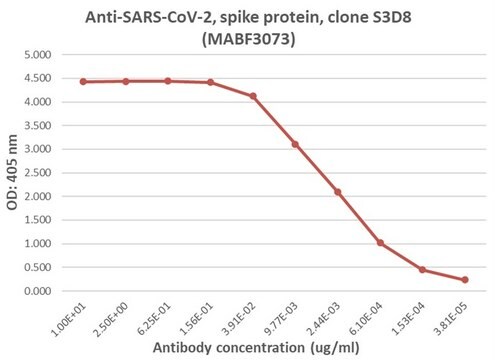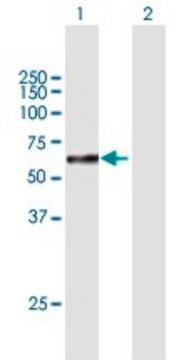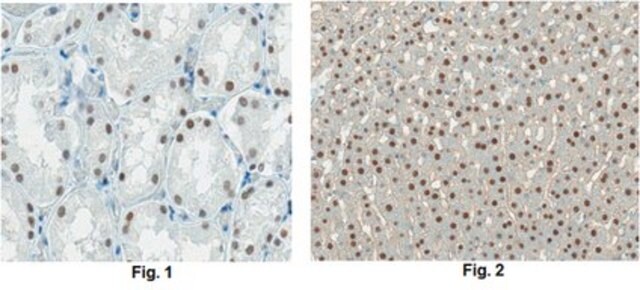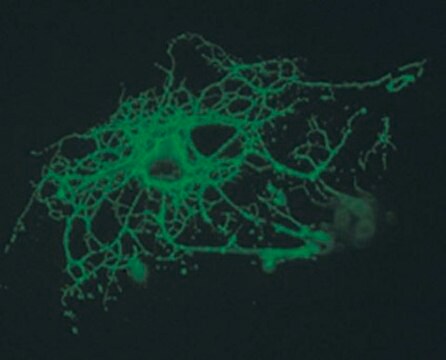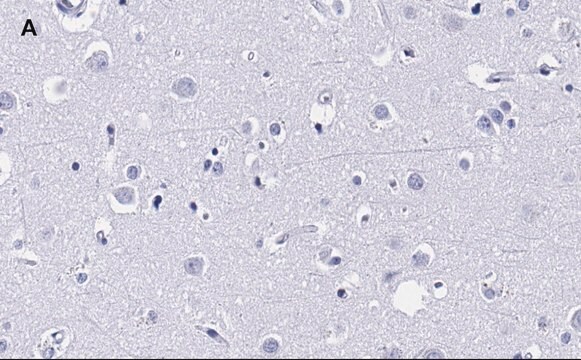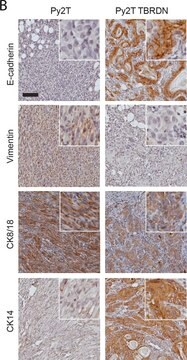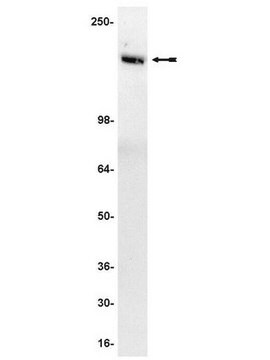MABF2797
Anti-SARS-CoV-2 Spike RBD Antibody, clone 7D1-C12
About This Item
Polecane produkty
pochodzenie biologiczne
mouse
Poziom jakości
białko sprzężone
unconjugated
forma przeciwciała
purified antibody
rodzaj przeciwciała
primary antibodies, primary antibodies
klon
7D1-C12, monoclonal
masa cząsteczkowa
calculated mol wt 141.18 kDa
observed mol wt ~200 kDa
oczyszczone przez
using protein G
reaktywność gatunkowa
SARS coronavirus
opakowanie
antibody small pack of 100 μg
metody
ELISA: suitable
immunoprecipitation (IP): suitable
neutralization: suitable
western blot: suitable
izotyp
IgG1κ
sekwencja epitopowa
Extracellular domain
numer dostępu UniProt
Warunki transportu
dry ice
docelowa modyfikacja potranslacyjna
unmodified
informacje o genach
vaccinia virus ... NS1(956533)
Opis ogólny
Specyficzność
Immunogen
Zastosowanie
Oceniane metodą Western Blotting w lizatach z komórek HEK293T wyrażających białko kolca SARS-CoV-2 o pełnej długości.
Analiza Western Blotting: Rozcieńczenie 1:1000 tego przeciwciała wykryło glikoproteinę kolca w lizacie z komórek HEK293T wyrażających białko kolca SARS-CoV-2 o pełnej długości, ale nie w lizacie z komórek HEK393T typu dzikiego.
Testowane aplikacje
Analiza Western Blotting: Rozcieńczenie 1:400 z reprezentatywnej partii wykryło glikoproteinę kolca w lizacie całych komórek HEK293T wyrażających białko kolca o pełnej długości SARS-CoV-2, ale nie w komórkach nietransfekowanych. (Dzięki uprzejmości Stefana Schüchnera, Ingrid Mudrak, Ingrid Frohner i E. Ogris (Max Perutz Labs, Uniwersytet Medyczny w Wiedniu, Austria).
Analiza ELISA: Różne rozcieńczenia supernatantu hodowli hybrydoma klonu 7D1-C12 wykryły natywne białko kolca SARS-CoV-2. (Dzięki uprzejmości Stefana Schüchnera, Ingrid Mudrak, Ingrid Frohner i E. Ogris (Max Perutz Labs, Uniwersytet Medyczny w Wiedniu, Austria).
Neutralizujące: Reprezentatywna partia tego przeciwciała zmniejszyła wiązanie RBD SARS-CoV-2 z receptorem ACE2 w teście interferencji wiązania. ((Dane dzięki uprzejmości: Kento Abe i Anne-Claude Gingras, University of Toronto, Kanada; Abe, KT., et al. (2020). JCI Insight. 5(19); e142362).
Analiza immunoprecypitacji: Reprezentatywna partia immunoprecypitowanej glikoproteiny spike wirusa SARS-CoV-2. (Dzięki uprzejmości Stefana Schüchnera, Ingrid Mudrak, Ingrid Frohner i E. Ogris (Max Perutz Labs, Uniwersytet Medyczny w Wiedniu, Austria).
Uwaga: Rzeczywiste optymalne rozcieńczenia robocze muszą być określone przez użytkownika końcowego jako próbki, a warunki eksperymentalne mogą się różnić w zależności od użytkownika końcowego.
Postać fizyczna
Przechowywanie i stabilność
Inne uwagi
Oświadczenie o zrzeczeniu się odpowiedzialności
Kod klasy składowania
12 - Non Combustible Liquids
Klasa zagrożenia wodnego (WGK)
WGK 2
Temperatura zapłonu (°F)
Not applicable
Temperatura zapłonu (°C)
Not applicable
Certyfikaty analizy (CoA)
Poszukaj Certyfikaty analizy (CoA), wpisując numer partii/serii produktów. Numery serii i partii można znaleźć na etykiecie produktu po słowach „seria” lub „partia”.
Masz już ten produkt?
Dokumenty związane z niedawno zakupionymi produktami zostały zamieszczone w Bibliotece dokumentów.
Nasz zespół naukowców ma doświadczenie we wszystkich obszarach badań, w tym w naukach przyrodniczych, materiałoznawstwie, syntezie chemicznej, chromatografii, analityce i wielu innych dziedzinach.
Skontaktuj się z zespołem ds. pomocy technicznej